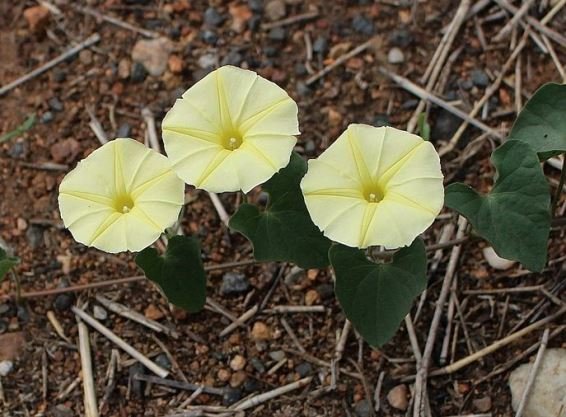Ipomoea

Author: Ivan Lätti
Photographer: Piet Grobler
Ipomoea is a genus of twining or erect herbs or undershrubs that are sometimes tuberous, rarely aquatic, often called morning glory. The genus forms part of the Convolvulaceae family, the largest genus of that family.
The generic name, Ipomoea, is derived from the Greek words, ipos meaning a woodworm or a strap and omoios meaning resembling, referring to the creeping habit of many of the species.
The alternate leaves are simple, heart-shaped at the base, oblong, lobed or divided.
The showy flowers are borne solitary or in cyme-shaped clusters from leaf axils. The calyx consists of five sepals. The pink to purple, white or cream corolla is broadly funnel-shaped or bell-shaped, five-lobed or the spreading part appearing folded into five equal sections.
The stamens arise near the base of the corolla tube, the anthers included in the tube. The filaments are sometimes dilated and often hairy at the base. The pollen is minutely spiny.
The superior ovary either has two locules, each containing two ovules or four locules with one ovule each; rarely three-locular. The style ends in a two- or three-lobed stigma.
The fruit is a globose capsule, sometimes an ovoid one. Its skin is leathery or membranous, sometimes fleshy. The capsules of some species dehisce. The seeds are sometimes hairy or silky.
There are about 500 Ipomoea species in tropical and subtropical regions worldwide, about 56 of which occur in southern Africa.
Many species are used medicinally and cultivated ornamentally. The tubers are edible, although there are poisonous species among them. The sweet potato is and Ipomoea, scientifically known as Ipomoea batatas. Another commonly eaten one is I. aquatica, widely known as water spinach, a semi-aquatic plant grown as a vegetable for its tender shoots.
The plant in picture is I. obscura var. obscura (Leistner, (Ed.), 2000; Manning, 2009; Pooley, 1998; Andrew, 2017; Wikipedia).

